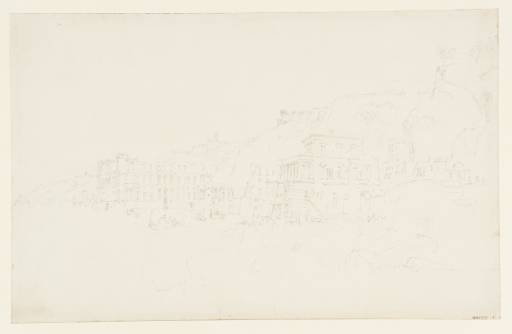Joseph Mallord William Turner Villas at Posillipo, Naples, including the Palazzo Donn'Anna and Palazzo della Rocella 1819
Image 1 of 2
Joseph Mallord William Turner,
Villas at Posillipo, Naples, including the Palazzo Donn'Anna and Palazzo della Rocella
1819
Joseph Mallord William Turner 1775–1851
Villas at Posillipo, Naples, including the Palazzo Donn’Anna and Palazzo della Rocella 1819
D16091
Turner Bequest CLXXXVII 4
Turner Bequest CLXXXVII 4
Pencil on white wove paper, 253 x 401 mm
Inscribed by the artist in pencil ‘I of Capria’ within sketch, bottom right
Inscribed by John Ruskin in blue ink ‘4’ bottom right, descending right-hand edge
Stamped in black ‘CLXXXVII 4’ and ‘7’ bottom right
Inscribed by the artist in pencil ‘I of Capria’ within sketch, bottom right
Inscribed by John Ruskin in blue ink ‘4’ bottom right, descending right-hand edge
Stamped in black ‘CLXXXVII 4’ and ‘7’ bottom right
Accepted by the nation as part of the Turner Bequest 1856
Exhibition history
1990
The Third Decade: Turner Watercolours 1810–1820, Tate Gallery, London, January–April 1990 (45, reproduced).
References
1909
A.J. Finberg, A Complete Inventory of the Drawings of the Turner Bequest, London 1909, vol.I, p.555, as ‘Naples’.
1905
E.T. Cook, Hidden Treasures of the National Gallery. A Selection of Studies and Drawings by J.M.W. Turner, R.A. Now Published for the First Time. With Some Account of Them. With a Sketch of Turner’s Life, and Reproductions of a Number of his Finished Works, London 1905, reproduced p.47, as ‘Posilipo, Bay of Naples’.
1984
Cecilia Powell, ‘Turner on Classic Ground: His Visits to Central and Southern Italy and Related Paintings and Drawings’, unpublished Ph.D thesis, Courtauld Institute of Art, University of London 1984, p.193 note 100.
1987
Cecilia Powell, Turner in the South: Rome, Naples, Florence, New Haven and London 1987, p.[86] note 76.
1990
Diane Perkins, The Third Decade: Turner Watercolours 1810–1820, exhibition catalogue, Tate Gallery, London 1990, no.45, p.41 reproduced, as ‘Naples’.
To the west of Naples lies the steep coastline of Posillipo, an area of outstanding natural beauty which since Roman times had been a popular residential district and resort. Turner’s drawing depicts villas along the start of the Posillipo shore, looking south-west from a point near the port of Mergellina.1 In the bottom right-hand corner of the sheet is a small separate outline study of the island of Capri, as seen from Posillipo.
The principal focus of the main view is two large shoreline villas. To the right is the seventeenth-century Palazzo della Rocella (present-day Villa Chierchia), whilst the building left of centre is the Palazzo Donn’Anna (also historically known as the Palace of Queen Joanna), a seventeenth-century palace built upon the remains of an earlier villa for the wife of the Spanish viceroy, Anna Carafa. When her husband left her to return to Spain in 1644, the unfinished palace was abandoned and neglected. The evocative, melancholy aura of the site was further heightened by a legend associated with Queen Giovanna II of D’Anjou (Joan or Joanna II), who is said to have entertained her lovers here before throwing them into the sea to their deaths. The grand but decaying building projecting directly into the sea presented an irresistible Neapolitan subject for eighteenth- and nineteenth-century artists and there are many paintings featuring this part of the coast.2 Further sketches of the Palazzo Donn’Anna can also be seen on other pages from this sketchbook (D16092; Turner Bequest CLXXXVII 5), whilst for the Palazzo della Rocella see the Naples, Paestum, Rome sketchbook (Tate D16063; Turner Bequest CLXXXVI 78).
For British visitors the attractions of Posillipo and the Palazzo Donn’Anna were heightened by the nearby presence of the Villa Emma, a small casino which had belonged to the antiquarian and diplomat, Sir William Hamilton (1731–1803), ambassador to the King of Naples (1764–1800) and husband of the celebrated beauty, Emma. The villa is just out of sight in Turner’s drawing but could be found on the beach to the immediate right of the Palazzo Donn’Anna, and appears in a number of topographical views dating from the late eighteenth century.3 Turner himself has copied a view of the casino and shoreline after John ‘Warwick’ Smith (1749–1831) in the Italian Guide Book sketchbook (see Tate D13969; Turner Bequest CLXXXII 20a, third from bottom right).4
Compare a virtually identical watercolour view by Giovanni Battista Lusieri (circa 1755–1821), Napoli. La costa di Posillipo (Fondazione Maurizio e Isabella Alisio, Naples), reproduced in Giuseppe Marcenaro and Piero Boragina, Viaggio in Italia: Un corteo magico dal Cinquecento al Novecento, exhibition catalogue, Palazzo Ducale, Genoa 2001, no.25, p.219.
See for example Pietro Fabris (active 1754–1804), The Procession of Royal Ships at Palazzo Donn’Anna (private collection), Abraham-Louis-Rodolphe Ducros (1747–1810), Posillipo seen from Palazzo Donn’Anna, Naples (Museum of San Martino), and Francis Towne (1739–1816), The Palazzo Donn’Anna (British Museum, London), all reproduced in Giuliano Briganti, Nicola Spinosa and Lindsay Stainton, In the Shadow of Vesuvius: Views of Naples from Baroque to Romanticism 1631–1830, exhibition catalogue, Accademia Italiana delle Arti e delle Arti Applicate, London 1990, pp.79, 89, 91.
For example William Pars (1742–1782), Sir William Hamilton’s Casino at Posillipo and the Ruins of the Palace of Queen Joan circa 1780 (Government Art Collection). See also Ian Jenkins and Kim Sloan, Vases & Volcanoes: Sir William Hamilton and his Collection, British Museum, London 1996, under no.17, pp.130–1, and under no.23, pp.137–8.
Technical notes:
Long detached from the Naples, Rome C. Studies sketchbook, this sheet was perhaps once folio 4 (see the concordance in the introduction).
Verso:
Inscribed by an unknown hand in pencil ‘[?M]’ bottom right, ascending right-hand edge.
Nicola Moorby
April 2010
How to cite
Nicola Moorby, ‘Villas at Posillipo, Naples, including the Palazzo Donn’Anna and Palazzo della Rocella 1819 by Joseph Mallord William Turner’, catalogue entry, April 2010, in David Blayney Brown (ed.), J.M.W. Turner: Sketchbooks, Drawings and Watercolours, Tate Research Publication, December 2012, https://www


